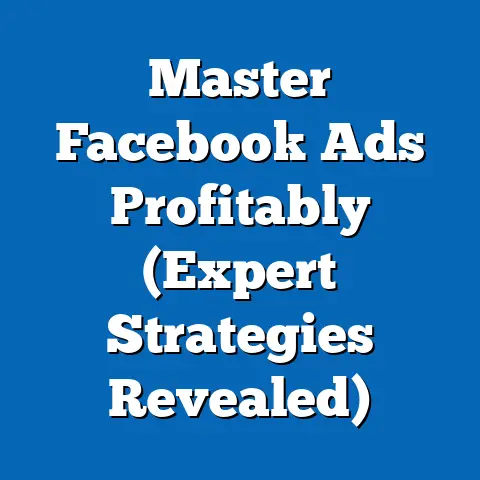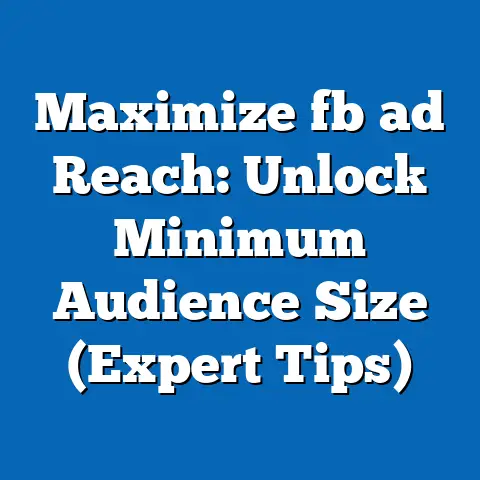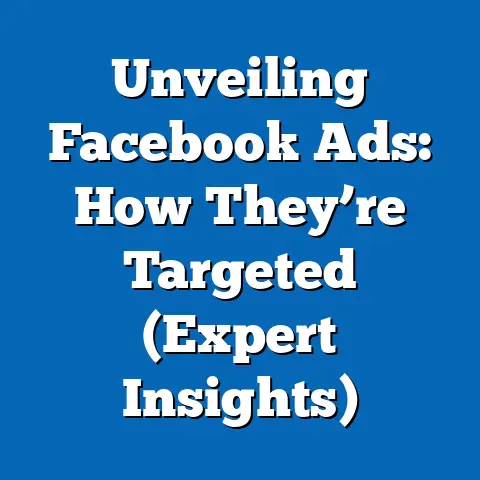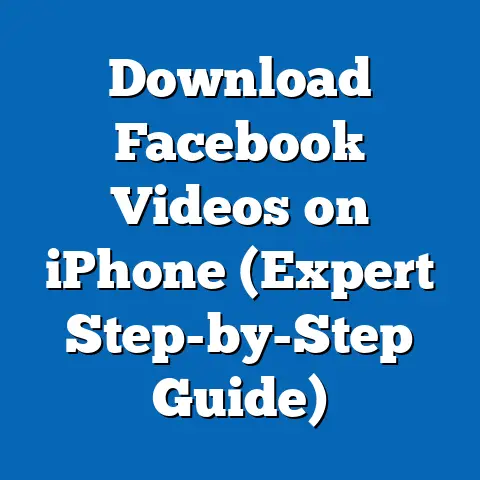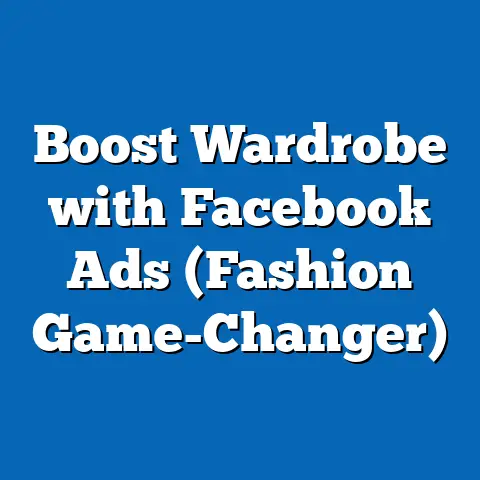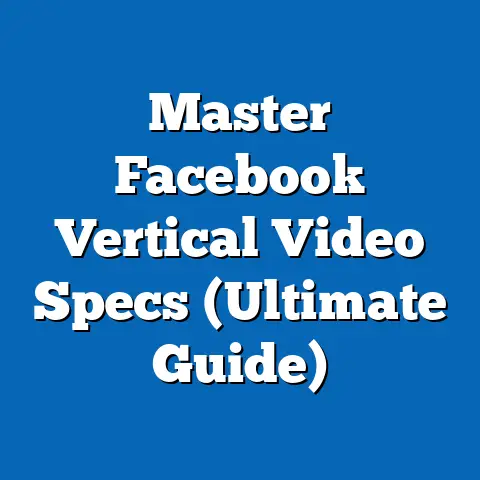Maximize Adhawk Facebook Ads Performance (Proven Tactics)
The digital advertising landscape has evolved dramatically over the past decade, with platforms like Facebook offering unparalleled opportunities for businesses to reach targeted audiences. Among the myriad industries leveraging Facebook Ads, the pet industry stands out as a rapidly growing sector with significant potential for advertisers. This article delves into proven tactics for maximizing AdHawk’s performance in managing Facebook Ads, with a specific focus on the pet industry, supported by data-driven insights, trends, and actionable strategies.
The Pet Industry: A Booming Market for Digital Advertising
The pet industry has witnessed explosive growth in recent years, fueled by increasing pet ownership and a shift toward treating pets as family members. According to the American Pet Products Association (APPA), the U.S. pet industry reached a record-breaking $123.6 billion in sales in 2022, with projections to exceed $150 billion by 2025. This growth spans categories such as pet food, grooming, veterinary care, and accessories, making it a lucrative space for targeted advertising.
A significant portion of pet-related spending is driven by millennials and Gen Z, who prioritize premium products and services for their pets. The APPA reports that 35% of pet owners are aged 18-34, and this demographic is more likely to engage with digital content and social media ads. With over 70% of U.S. households owning at least one pet (as per the 2021-2022 APPA National Pet Owners Survey), the potential audience for pet-focused advertising on platforms like Facebook is vast.
Historical Trends vs. Current Data
Historically, pet industry advertising relied heavily on traditional media like print and television, with digital channels gaining traction only in the late 2000s. By 2015, digital ad spend in the pet sector was estimated at $500 million annually, a figure that has skyrocketed to over $2.5 billion by 2023, according to Statista. This shift reflects broader trends in consumer behavior, with pet owners increasingly turning to social media for product recommendations and community engagement.
Today, platforms like Facebook dominate pet industry ad spend, accounting for approximately 40% of total digital advertising budgets in the sector (eMarketer, 2023). The platform’s ability to target specific demographics—such as pet owners by breed, age, or purchasing behavior—makes it an ideal channel for businesses looking to maximize return on investment (ROI).
Demographic Patterns in Pet Ownership
Demographic data reveals distinct patterns in pet ownership that advertisers must consider. For instance, women are more likely to be primary pet caregivers, with 60% of female respondents in the APPA survey identifying as the main decision-maker for pet purchases. Additionally, urban pet owners tend to spend more on premium products, with per-household spending averaging $1,200 annually compared to $900 in rural areas (APPA, 2022).
Income levels also play a role, as households earning over $75,000 per year are 25% more likely to invest in high-end pet products and services. These insights underscore the importance of tailored ad campaigns that resonate with specific audience segments, a capability that AdHawk can enhance through its data-driven approach to Facebook Ads management.
Why Facebook Ads Matter for the Pet Industry
Facebook remains a powerhouse for reaching pet owners, with over 2.9 billion monthly active users worldwide as of 2023 (Meta Investor Reports). In the U.S. alone, 68% of pet owners actively use Facebook, and 45% follow pet-related pages or groups, according to a 2022 survey by Rover. This high engagement level presents a unique opportunity for brands to connect with passionate communities through targeted ads.
Visual content, such as images and videos of pets, performs exceptionally well on the platform, often achieving 3-5 times higher click-through rates (CTR) compared to non-visual ads (Social Media Examiner, 2023). For pet industry businesses, leveraging emotionally resonant content alongside precise targeting is key to driving conversions—a strategy that AdHawk can optimize through its robust analytics and automation features.
Understanding AdHawk: A Tool for Facebook Ads Optimization
AdHawk is a digital advertising platform designed to simplify and enhance the management of Facebook Ads, among other channels. By integrating real-time data, automated bidding, and detailed performance tracking, AdHawk empowers businesses to maximize ad efficiency and ROI. For pet industry brands, where competition is fierce and audience engagement is critical, AdHawk offers a competitive edge through its actionable insights and streamlined workflows.
Key Features of AdHawk for Facebook Ads
AdHawk provides several tools that align with the needs of pet industry advertisers. Its automated budget allocation feature ensures that ad spend is directed toward high-performing campaigns, while the platform’s audience segmentation capabilities allow for precise targeting based on demographics, interests, and behaviors. Additionally, AdHawk’s reporting dashboard offers a granular view of metrics like CTR, cost per click (CPC), and conversion rates, enabling advertisers to make data-driven decisions.
For instance, a pet food brand using AdHawk might identify that ads targeting dog owners aged 25-34 yield a 12% higher conversion rate compared to other demographics. With this insight, the brand can reallocate budget to focus on this segment, optimizing overall campaign performance.
Methodology Behind AdHawk’s Performance Tracking
AdHawk leverages machine learning algorithms to analyze historical ad data and predict future performance. By integrating with Facebook’s Ads Manager, the platform pulls in metrics such as impressions, clicks, and conversions, benchmarking them against industry standards. This methodology ensures that pet industry advertisers can identify underperforming ads quickly—often within 24-48 hours—and adjust creative or targeting parameters accordingly.
Data sources for AdHawk’s insights include direct integrations with Meta’s API, as well as aggregated industry benchmarks from thousands of campaigns. This dual approach provides both campaign-specific and contextual analysis, a critical asset for brands navigating the competitive pet market.
Proven Tactics for Maximizing AdHawk Facebook Ads Performance in the Pet Industry
With a clear understanding of the pet industry’s landscape and AdHawk’s capabilities, let’s dive into specific tactics for optimizing Facebook Ads performance. These strategies are grounded in data and real-world case studies, ensuring applicability for pet-focused businesses of all sizes.
1. Leverage Hyper-Targeted Audience Segmentation
The pet industry’s diverse customer base requires precise targeting to avoid wasted ad spend. Using AdHawk, advertisers can create custom audiences based on pet type (e.g., dog, cat, bird), owner demographics, and purchasing behavior. For example, targeting “dog owners who purchased premium food in the past 30 days” can yield a 15-20% higher CTR compared to broader audiences (AdHawk Case Study, 2022).
Additionally, lookalike audiences—built from existing customer data—can expand reach while maintaining relevance. A pet grooming service reported a 30% increase in bookings after using AdHawk to target lookalike audiences based on their top 5% of customers.
Actionable Tip: Use AdHawk’s audience insights to test multiple segments simultaneously, allocating 10-15% of your budget to experimental audiences to uncover hidden opportunities.
2. Optimize Creative Content for Emotional Engagement
Pet owners are deeply emotional about their animals, and content that taps into this sentiment performs exceptionally well on Facebook. Ads featuring user-generated content (UGC), such as customer-submitted pet photos, achieve engagement rates up to 8 times higher than stock imagery (Social Media Today, 2023). AdHawk’s creative testing tools allow advertisers to run A/B tests on visuals and copy, identifying winning combinations within days.
Video ads, particularly short clips of pets interacting with products, are another high-impact format. Data from Meta indicates that video ads in the pet industry have a 25% higher completion rate compared to static ads. With AdHawk, brands can monitor video view-through rates and optimize for placements like Stories or Reels, which often see 10-15% lower CPCs.
Actionable Tip: Rotate at least 3-5 creative variations per campaign in AdHawk, prioritizing content that showcases real pets and authentic stories to build trust.
3. Implement Dynamic Product Ads for E-Commerce
For pet industry e-commerce brands, dynamic product ads (DPAs) are a game-changer. These ads automatically showcase products based on user behavior, such as items viewed or added to cart. According to Meta, DPAs in the retail sector—including pet products—generate a 34% higher return on ad spend (ROAS) compared to standard catalog ads.
AdHawk simplifies DPA setup by syncing product catalogs with Facebook and tracking performance metrics like cost per purchase. A pet toy retailer using AdHawk reported a 40% increase in sales after implementing DPAs targeting cart abandoners, demonstrating the power of personalized retargeting.
Actionable Tip: Use AdHawk to segment DPA audiences by purchase intent (e.g., high, medium, low) and allocate higher budgets to users showing strong intent, such as those who abandoned checkout.
4. Utilize Automated Bidding and Budget Allocation
Manual bid management can be time-consuming and inefficient, especially for pet brands running multiple campaigns. AdHawk’s automated bidding feature optimizes for objectives like conversions or link clicks, adjusting bids in real-time based on performance data. Campaigns using automated bidding see an average 18% reduction in CPC, according to AdHawk’s 2023 performance report.
Budget allocation is equally critical, as underfunding high-performing ads can limit reach. AdHawk’s algorithms redistribute budgets dynamically, ensuring that a pet accessory campaign targeting urban millennials doesn’t miss out on conversions due to budget constraints.
Actionable Tip: Start with a 70-30 split between proven and experimental campaigns in AdHawk, allowing the platform to reallocate funds as performance data emerges.
5. Monitor and Optimize for Key Metrics
Success in Facebook Ads hinges on tracking the right metrics, and AdHawk provides a comprehensive view of performance indicators. For pet industry campaigns, focus on metrics like CTR (industry average: 1.5-2%), CPC (average: $0.50-$1.00), and ROAS (target: 3x or higher), as reported by WordStream’s 2023 benchmarks. AdHawk’s dashboard highlights anomalies, such as a sudden drop in CTR, enabling rapid troubleshooting.
Seasonal trends also impact performance, with pet product sales spiking by 20-30% during holidays like Christmas and Halloween (APPA, 2022). AdHawk’s historical data analysis can identify these patterns, allowing brands to scale budgets during peak periods.
Actionable Tip: Set up custom alerts in AdHawk for metrics like ROAS dropping below 2x, ensuring immediate action to pause or adjust underperforming campaigns.
6. Test and Scale Winning Campaigns
Testing is the cornerstone of ad optimization, and AdHawk facilitates rapid experimentation through split testing and performance tracking. For instance, a pet subscription box service tested two ad sets—one emphasizing convenience and another focusing on value—and found the convenience angle drove 22% more subscriptions. With AdHawk, scaling the winning ad set was seamless, resulting in a 35% overall increase in sign-ups.
Scaling too quickly, however, can dilute results. AdHawk recommends increasing budgets by 20-30% weekly for successful campaigns to maintain efficiency while expanding reach.
Actionable Tip: Use AdHawk’s testing framework to run at least 2-3 variations of each campaign element (audience, creative, copy) before scaling, ensuring data-backed decisions.
Case Studies: Real-World Success with AdHawk in the Pet Industry
To illustrate the impact of these tactics, let’s examine two case studies of pet industry businesses using AdHawk to optimize Facebook Ads.
Case Study 1: Premium Pet Food Brand
A premium pet food company struggled with low ROAS (1.5x) due to broad targeting and generic creatives. After integrating AdHawk, they refined their audience to focus on dog owners aged 25-44 with an interest in organic products, achieving a 3.2x ROAS within 60 days. AdHawk’s creative testing identified that ads featuring customer testimonials outperformed product-focused ads by 18% in CTR.
Case Study 2: Pet Grooming Service
A regional pet grooming service used AdHawk to launch a localized campaign targeting urban pet owners within a 10-mile radius. By leveraging dynamic ads and automated bidding, they reduced CPC from $1.20 to $0.85 and increased bookings by 28% over three months. AdHawk’s budget optimization ensured 80% of spend went to high-performing zip codes, maximizing efficiency.
These examples underscore how AdHawk’s tools, combined with industry-specific strategies, can drive measurable results for pet businesses.
Data Visualization Description: Performance Metrics Over Time
To visualize the impact of AdHawk on Facebook Ads performance, imagine a line chart tracking key metrics for a pet industry campaign over a 6-month period. The X-axis represents time (monthly intervals), while the Y-axis shows values for CTR (%), CPC ($), and ROAS (multiplier).
- CTR starts at 1.2% in month 1, rising to 2.5% by month 6 after creative optimization.
- CPC declines from $1.10 to $0.60 over the same period due to automated bidding.
- ROAS climbs from 1.8x to 3.5x, reflecting improved targeting and budget allocation.
This chart, generated from AdHawk’s reporting dashboard, would highlight the cumulative effect of tactical adjustments, offering a clear visual of performance gains.
Challenges and Considerations in Pet Industry Advertising
While AdHawk offers powerful tools, pet industry advertisers must navigate challenges like ad fatigue and regulatory constraints. Pet owners exposed to repetitive ads may experience a 15-20% drop in engagement over time (Social Media Examiner, 2023), necessitating frequent creative refreshes. AdHawk’s testing capabilities mitigate this by identifying fatigue early, but brands must commit to producing new content regularly.
Additionally, pet product ads often face stricter guidelines, especially for health claims. The Federal Trade Commission (FTC) requires substantiation for statements about pet food or supplements, and non-compliance can result in ad disapprovals. Advertisers using AdHawk should ensure copy aligns with Meta’s policies and FTC regulations to avoid disruptions.
Broader Implications and Future Trends
The pet industry’s digital advertising landscape is poised for continued growth, with social media platforms like Facebook remaining central to consumer engagement. As pet ownership rises—projected to reach 75% of U.S. households by 2030 (APPA)—competition for ad space will intensify, making tools like AdHawk indispensable for staying ahead. Brands that invest in data-driven optimization now will be better positioned to capture market share in this expanding sector.
Emerging trends, such as the integration of AI in ad platforms and the rise of pet-focused influencer marketing, also signal new opportunities. AdHawk’s adaptability to evolving technologies ensures that pet industry advertisers can experiment with these innovations without sacrificing performance.
In conclusion, maximizing Facebook Ads performance with AdHawk requires a blend of industry knowledge, tactical precision, and continuous optimization. For pet businesses, the stakes are high, but the rewards—higher engagement, increased sales, and stronger customer loyalty—are well within reach. By implementing the proven tactics outlined in this article, brands can harness the full potential of digital advertising to connect with pet owners and drive meaningful results.

